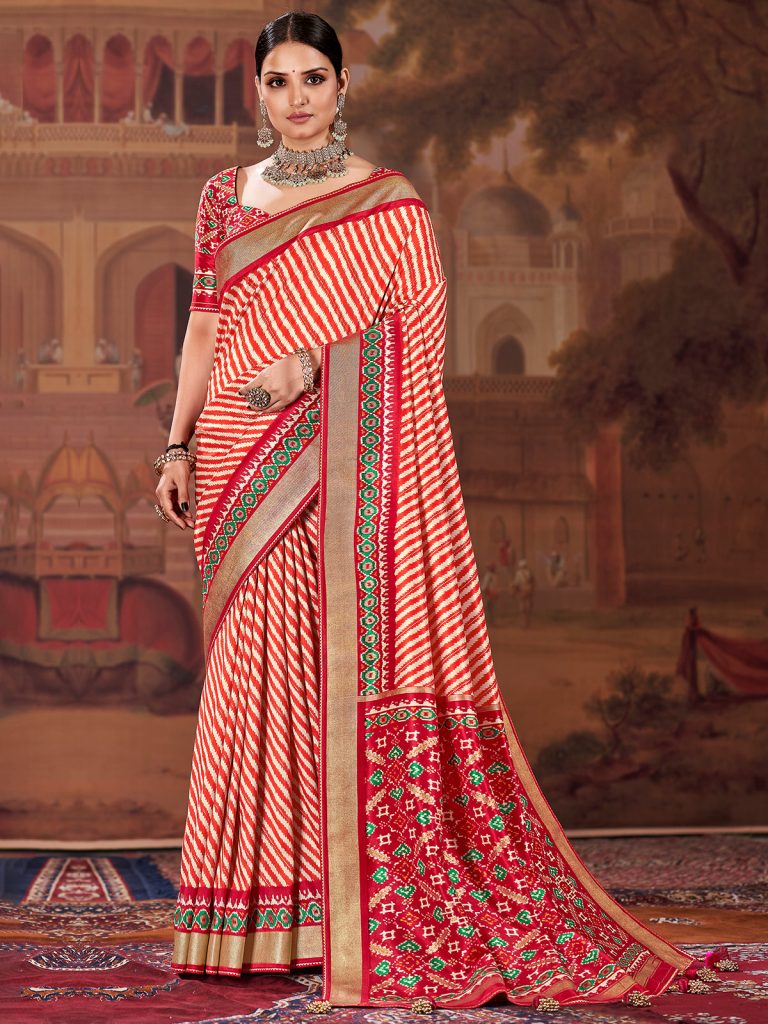The bridal silk saree comes in various designs and patterns. It is one of the oldest and traditional forms of clothing worn by all Indian women. It has a great ethnic significance, also it is one of the most graceful attire which is famous in all age group of women. Any Indian woman looks fabulous when draping in a silk saree.
The tradition of wearing a bridal silk saree for marriages is formed from an early age. It is worn in many other auspicious ceremonies is a custom in Assam and southern parts of India. Silk is considered as one of the of royalty, and, historically, silk is used primarily by the upper classes. Silk garments and sarees produced in Kanchipuram, Pochampally, Dharmavaram, Mysore, Arani in the south, Banaras in the north, Bhagalpur and Murshidabad in the east are well recognized.
In the northeastern state of Assam, three different types of silk saree are produced, collectively called Assam silk, Muga, Eri and Pat silk. Muga, the golden silk, and Eri are produced by silkworms that are native only to Assam.
Well, the bridal silk saree has many more values and importance and is worn in different festivals and ceremonies. Here are the few types of bridal silk sarees you should consider wearing for a wedding.
Kanchivaram Silk Saree
The Kanchivaram silk saree is also named Kanchipuram sarees which are basically made in the Kanchipuram region in Tamil Nadu, India. The main occupation of the Kanchipuram people is weaving silk. These sarees are worn as a bridal and special occasion by most women of South India.
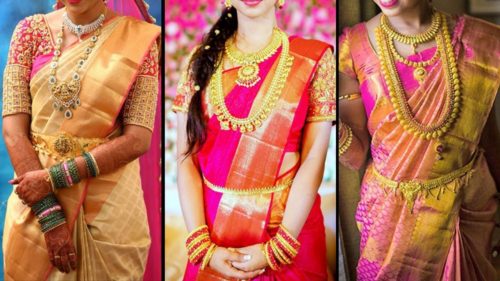
The Kanchipuram Silk Saree is handwoven with dyed silk yarn and interleaved designs made with zari which is a silk thread twisted with a thin silver wire and then gilded with pure gold.
They are woven from pure mulberry silk and hence have a great reputation for the texture, luster, durability, and finish. The motifs used in an Indian Kanchipuram sarees are heavily based on the Pallava temples, palaces, and paintings.
Talking about its design, the sarees are distinguished by their wide contrast borders. Temple borders, checks, stripes, and floral buttas are traditional designs found on a Kanchipuram sarees. The patterns and designs in the Kanchipuram sarees is inspire by images and scriptures in South Indian temples or natural features like leaves, birds, and animals.
Banarasi Silk Saree Design
One of the most wearable bridal silk saree is a Banarasi saree. It is a clothing which is made in Varanasi, a city which is also known as “Benares” or “Banaras”. The Banarasi sarees are among the finest sarees in India and are known for their gold and silver brocade or zari, fine silk, and opulent embroidery. Saree woven from this fine silk is known as Banarasi silk saree which is extremely popular all over India. Banarasi saree is adorned with intricate designs and zari embellishments make it popular during traditional functions and weddings.
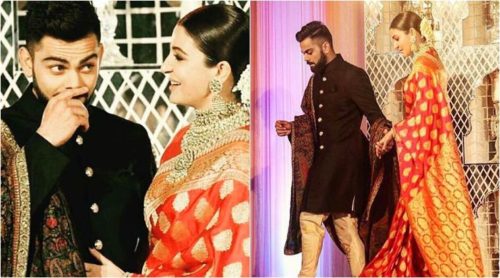
The traditional Banarasi saree has been done with lots of hard work using silk. The special characteristics of these sarees are their designs, which are Mughal inspired. Most often, it has been decorated with intricate floral as well as foliate designs. Normally it takes fifteen days to six months to complete single Banarasi saree, it might also take even a year if the designs are complex.
Patola Saree
Patola is a double ikat woven saree which is made from silk. The patola saree is originated from Patan, Gujarat, India. Patola-weaving is a closely guarded family tradition. It can take six months to one year to make one sari due to the long process of dying each strand separately before weaving them together. Because of this, the price of patola saree is very expensive. Patola was woven in Surat, Ahmedabad, and Patan.
To create a patola sari, both the warp and weft threads are wrapped to resist the dye according to the desired pattern of the final woven fabric. This tying is repeated for each color that is to be included in the finished cloth. The technique of dyeing the warp and weft before weaving is called double ikat. The bundles of thread are strategically knotted before dyeing.
Baluchari Silk Saree for Women
Mostly the Baluchari saree is worn by the women of India and Bangladesh. These sarees is originate in West Bengal. The Baluchari sarees are distinguished by artistic motifs depicting scenes from Ramayana or sculptures made on historic temples that are woven on the saree borders. Nowadays, the Baluchari sarees are woven using highly mercerized cotton thread and silky threadwork ornament in bold colors. It would take two craftsmen working for almost a week to produce one saree.
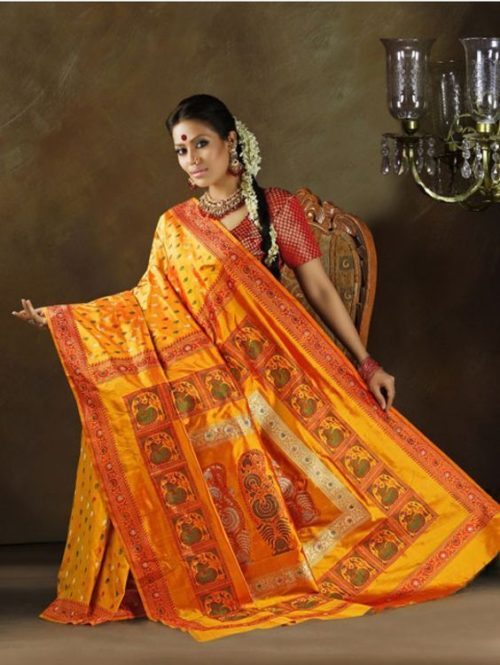
The colors and yarns which are used while weaving the Baluchari sarees are very bright and eco-friendly. The Baluchari sarees are known for their intricate designs and handwork on them, whereas the mythological designs make a Baluchari saree perfect for festive occasions and weddings. While there isn’t a lot of variation in the method of weaving used today, Baluchari can be broadly categorized based on the threads used in weaving the patterns:
- Baluchari (Resham): The simplest Baluchari have Resham threads in a single color to weave the entire pattern
- Baluchari (meenakari): These balucharis have threads in two or more colors with attractive meenakari work that further brightens the patterns
- Swarnachari (baluchari in gold), also called Swarnachuri: They are the most gorgeous Baluchari, woven with gold (Swarna) or silver-colored threads (often with meenakari work in another color) that illuminate the patterns to a much larger extent.
Paithani Silk Saree Design
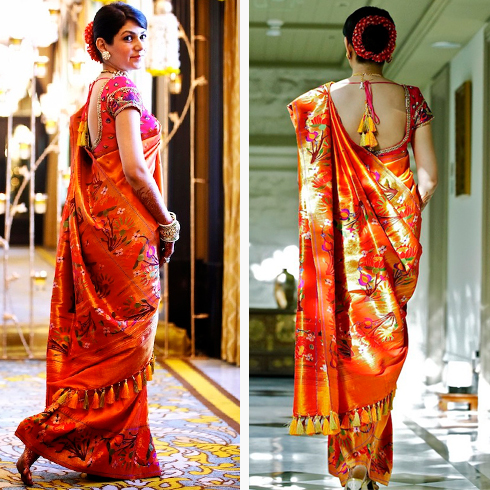
Paithani sarees are made from pure silk and considered as one of the richest saree in Maharashtra. These sarees are woven by hand and is made from very fine silk. Mostly the paithani sarees are worn by the Maharashtrian women in their wedding and traditional festive occasions.
The main specialty of the paithani saree is its border which has a square design, and a pallu with a colorful peacock design which enhances the charm of the saree. The motifs on the body of this saree are also one of the attractive features. Colors like yellow, red, lavender, purple, sky blue, magenta, peach pink, purple, blue/green, yellowish-green, violet red, black, white goes well for the bride.
Korial Silk Saree

The Korial sarees are the most famous and traditional attire worn by Bengali women. The rich silky texture of this saree is quite sophisticated and comes with a white and off-white silk body and a red border and pallu.
It is mainly worn during the wedding and religious occasions like Durga puja. The combination of white and red with zari or kolka butti work on pallu is the main attraction of this saree.
Read more on How to Wear Saree for Wedding Party – Saree Draping Styles for Party


